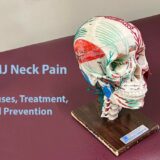chronic pain

Chronic Pain and how to define it?
Chronic pain is defined as pain that has lasted longer than three to six months, though some theorists and researchers have placed the transition from acute to chronic pain at 12 months. Others apply acute to pain that lasts less than 30 days, chronic to pain of more than six months duration, and subacute to pain that lasts from one to six months. A popular alternative definition of chronic pain, involving no arbitrarily fixed durations, is “pain that extends beyond the expected period of healing”. There is little evidence for effectively treating most types of severe, acute pain with opioids. An exception is ongoing, intense pain due to cancer. While they may improve pain in the short term there is no evidence of improved long-term pain or functioning. Risks include overdose and addiction. In the United States, about 100 million people have chronic pain, with 25% of those having more severe pain.
Ongoing scientific evidence suggests that some multidisciplinary health approaches may help people better manage chronic pain.
Definitions from Several Experts:
- Hopkins Medical defines it as “Chronic pain is long-standing pain that persists beyond the usual recovery period or occurs along with a chronic health condition, such as arthritis. Chronic pain may be “on” and “off” or continuous. It may affect people to the point that they can’t work, eat properly, take part in physical activity, or enjoy life.
- Chronic Pain Institute: “Many of us have experienced pain to some degree throughout the course of our lives. We may understand what pain can feel like, but it can still be difficult to fully define. A good definition of pain is “an unpleasant sensory and emotional experience associated with actual or potential tissue damage. While most definitions give the scientific description of pain, the emotional and physical effects can be difficult to describe, as they vary from person to person. The following sections are available to help you better understand pain so that you can seek proper treatment from your pain specialist.
- Mayo Clinic says: “Chronic pain is pain that isn’t due to a temporary cause and typically lasts longer than three months. Chronic pain can be constant or can come and go. You might have some painful days during the week and some pain-free, or you might have pain at certain times of the day and not others.
- NIH defines it as: “It is pain that lasts more than several months (variously defined as 3 to 6 months, but longer than “normal healing”). It’s a very common problem. Results from the 2012 National Health Interview Survey show that:
– About 25.3 million U.S. adults (11.2 percent) had pain every day for the previous 3 months.
– Nearly 40 million adults (17.6 percent) had severe pain.
– Individuals with severe pain had worse health, used more health care, and had more disability than those with less severe pain.
Guidelines for the Treatment of Chronic Pain Conditions
National health professional organizations like the CDC have issued guidelines for treating several chronic pain conditions. Some mention ways in which health approaches to treating head and neck pain can be incorporated into treatment plans. Others discourage the use of certain opioid prescription approaches.
A clinical practice guideline from the American College of Physicians encourages the use of nonpharmacologic approaches as initial treatment for chronic low-back pain. The options they suggest include several complementary approaches—acupuncture, mindfulness-based stress reduction, tai chi, yoga, progressive relaxation, biofeedback, and spinal manipulation—as well as conventional methods such as exercise and cognitive behavioral therapy.
In light of the human and healthcare costs of chronic pain, as well as evidence that many patients who have chronic pain turn to pain specialists for relief. The CDD, FDA, and NCCIH place a high priority on pain-related research. Yet today, researchers in this area still face challenges: much remains to be understood about the nature of chronic pain and about the best ways of studying its many causes, people’s different responses, and the value of various treatment approaches— including conservative and conventional. The ultimate goal is to build an evidence base that can guide pain management decisions and complement clinician judgment. These decisions often involve combining treatment approaches in cost-effective ways to best help chronic pain patients minimize pain, carry out everyday activities, and improve their quality of life.
At the Minnesota Head and Neck Pain Clinics, we know that acute pain is a complex challenge that often affects many areas of a person’s life. Our goal is to provide chronic pain relief, reduce or manage chronic pain to improve a patient’s life, and allow them to return to a more normal, active, and productive lifestyle.
Image source: Photo illustration by Rayne Zaayman-Gallant of the European Molecular Biology Laboratory (Creative Commons CC BY-NC-ND 4.0)


